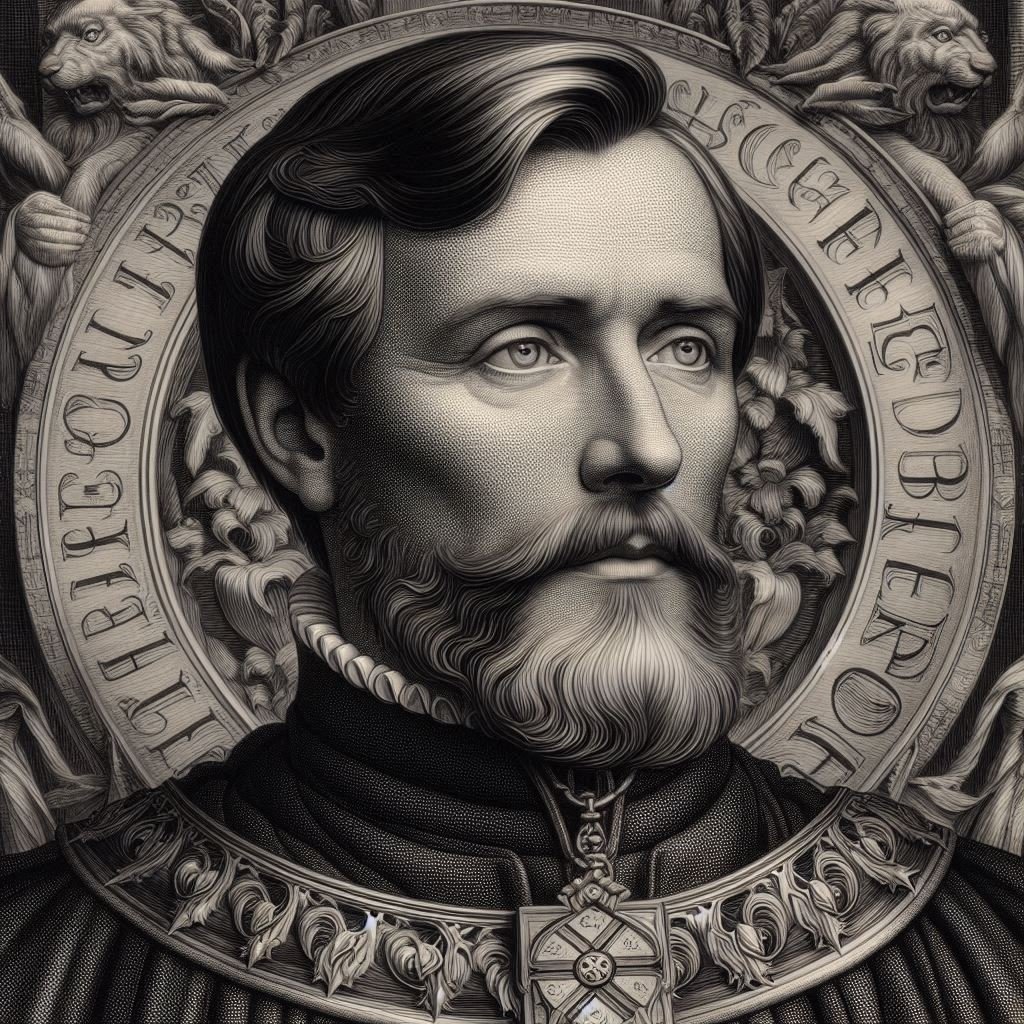This article examines the Lawson-Tancred family who are related to Aldborough Hall, located within the remains of Isurium Brigantium Roman town.
The Lawson-Tancred family, with its roots deeply embedded in English history, boasts several notable figures who have made significant contributions to their fields and society. The lineage of the family can be traced back to the Norman Conquest, with Richard Tankard, who owned lands at Boroughbridge in Yorkshire shortly after this pivotal event in English history. This ancestral connection sets the stage for a family history interwoven with the fabric of England’s development.
The Tancred family owes much of its later prestige to Tancred Hauteville, a notable figure during the First Crusade and Prince of Galilee, is ancestrally related to Richard Tankard. The lineage of the Tancred family, originating from the noble House of Hauteville, extends to the Tankards of Yorkshire, England. Historical records indicate that the Tancred family held a family seat as Lords of the Manor of Boroughbridge in Yorkshire, descending from Tancred, son of the Good Marquis, who governed the Principality of Antioch. This Tancred was also the progenitor of the celebrated Tankervilles, a branch of the family that held significant influence and land in Normandy since 912 A.D.
Contents
Tancred’s in the Crusades
In the realm of military history, the Tankards’ ancestral connection to the Crusader Tancred added a layer of martial prestige to their name. The valour and leadership displayed by Tancred during the First Crusade were qualities that resonated with the chivalric ideals of the time and were celebrated by his descendants.
The rise of the Tancred family to royalty in Galilee is a tale woven through the fabric of medieval geopolitics, marked by the astute forging of alliances through marriage. Tancred, a scion of the noble House of Hauteville, emerged as a prominent figure during the First Crusade, demonstrating military prowess and strategic acumen. His lineage, tracing back to the Italo-Norman nobility, already endowed him with a significant status among the crusading rank; however, his military career is a testament to the martial spirit of the era.
Born into the noble lineage of the House of Hauteville, his early life was steeped in the traditions of Norman knighthood, which prized courage and prowess in battle. As a young knight, Tancred’s destiny was irrevocably intertwined with the First Crusade, a monumental expedition that sought to reclaim the Holy Land from Muslim rule. His uncle, Bohemond of Taranto, recognized Tancred’s potential and brought him along as a trusted lieutenant, a decision that would prove pivotal in the campaigns to come.
In the initial stages of the Crusade, Tancred’s martial skills shone brightly. He was instrumental in the capture of key cities in Cilicia, where his leadership and tactical acumen were on full display. His refusal to swear fealty to the Byzantine Emperor Alexius I Comnenus underscored his fierce independence and commitment to the crusader cause. This act of defiance, though controversial, cemented his reputation as a principled warrior among his peers.
The Siege of Antioch
The Siege of Antioch in 1097 was a crucible that tested the mettle of all involved, and Tancred emerged as one of its most formidable commanders. His valour in the face of overwhelming odds and his strategic insight during the siege contributed significantly to the crusaders’ eventual victory. The fall of Antioch was a turning point in the Crusade, and Tancred’s role in it elevated his status among the crusading nobility.
Following the capture of Antioch, Tancred’s military endeavours continued to shape the landscape of the Levant. He engaged in several skirmishes and battles, expanding the crusaders’ territories and consolidating their gains. His victory over Radwan of Aleppo at the Battle of Artah in 1105 was particularly noteworthy, as it allowed the Latin principality to reclaim territories east of the Orontes River, bolstering the crusader states’ position in the region.
Prince of Galilee and regent of Antioch
Tancred’s tenure as Prince of Galilee and regent of Antioch saw him navigate the complex political and military landscape of the Crusader States with skill. He twice took over for Bohemond as Prince of Antioch, first during Bohemond’s captivity and again after his return to the West. In these roles, Tancred demonstrated not only martial prowess but also a keen understanding of governance and statecraft. His rule was marked by efforts to strengthen the crusader states’ infrastructure and defences, ensuring their longevity against external threats.
The Gesta Tancredi, a Latin account of the First Crusade composed by Ralph of Caen, offers a unique perspective on Tancred’s exploits. Though seldom studied, this narrative highlights the complexity of Tancred’s character, portraying him as both a restrained and ruthless leader, faithful to his allies yet capable of decisive action when necessary.
In literature, Tancred’s military exploits have been immortalized in various works, including La Chanson d’Antioche, where he is depicted alongside Bohemond, albeit with less preferential treatment. These portrayals reflect the multifaceted nature of his legacy, which remains a subject of scholarly debate to this day.
After the pivotal Siege of Antioch, Tancred played a significant role in the Battle of Jerusalem in 1099, where he was among the first crusaders to breach the city’s defences. His actions during the siege were crucial in the eventual capture and control of Jerusalem, a momentous victory for the crusading forces.
In the aftermath of Jerusalem’s fall, Tancred continued to engage in military operations that expanded the crusaders’ territories. He was involved in the Battle of Artah in 1105, where he led the crusader forces against the Seljuk Turks of Aleppo. The battle was a decisive victory for Tancred, allowing him to consolidate control over the region and secure the eastern frontier of the Principality of Antioch.
The Skirmish at the Cilician Gates
Another notable engagement was the skirmish at the Cilician Gates, where Tancred displayed his tactical acumen by navigating through this treacherous pass and seizing important cities in Cilicia. This manoeuvre not only demonstrated his military skill, but also his ability to strategically acquire key locations that would benefit the crusader states.
Tancred’s military endeavours were not limited to large-scale battles; he also excelled in smaller skirmishes and sieges that were pivotal in establishing the crusaders’ presence in the Levant. His ability to adapt to various combat situations and his leadership qualities made him a formidable opponent on the battlefield and a respected figure among his peers.
Marriage to Cécile of France
However, it was his marriage to Cécile of France that catapulted the Tancred name into the annals of royalty within the Levant.
Cécile, being the progeny of Philip I of France, brought with her not just a royal connection but a network of political alliances that extended throughout Europe. This union was emblematic of the era’s diplomatic marriages, which were less about romance and more about the consolidation of power and territory. Through this marriage, Tancred secured a foothold in the intricate web of European nobility, ensuring support and recognition for his endeavours in the Holy Land.
As Prince of Galilee and later as regent of Antioch, Tancred’s rule was characterized by a blend of military might and political savvy. He expanded his territories, not just through conquest but also through the establishment of vassal states and the strategic placement of loyalists in positions of power. His governance of Galilee was marked by a period of relative stability and prosperity amidst the tumultuous backdrop of the Crusader States.
The principality itself was a mosaic of cultures and religions, and Tancred’s leadership was pivotal in navigating the complexities of ruling such a diverse region. His ability to maintain control and influence over Galilee was in part due to the prestige his marriage to Cécile brought, as well as his own martial and administrative capabilities. The Tancred family’s ascent to royalty was thus a confluence of strategic matrimonial ties, military successes, and adept governance, setting a precedent for the politics of lineage and alliance that would define the era.
The Tankard’s
This ancestral link between Tancred and Richard Tankard is a fascinating example of how noble lineages were preserved and celebrated throughout history, with each generation building upon the legacy of the previous. The Tancred’s and Tankards, through their shared lineage, exemplify the enduring nature of noble families and their impact on the historical and social landscapes of their respective eras. The story of Tancred’s rise to royalty in Galilee and the subsequent history of the Tankards in England is a testament to the power of lineage, legacy, and the lasting influence of the Norman nobility in medieval Europe.
Richard Tankard, a descendant of this illustrious line, owned lands at Boroughbridge in Yorkshire. The Tankard family’s history is intertwined with the Tancred’s through a series of strategic marriages and inheritances that consolidated their power and influence over the centuries. The Tankards, like the Tancred’s, were part of the Norman aristocracy that settled in England following the Norman Conquest. Their name, borne from the ancient Norman given name Tancred, reflects the familial connection and shared heritage.
The Tankards continued the legacy of their forebear, Tancred, by maintaining their status as landowners and contributing to the local governance and social fabric of Yorkshire. Over time, the family’s influence waned, but their historical connection to the Tancred’s of the Crusader States remained a point of ancestral pride. The Tancred family’s rise to prominence in the medieval period, marked by military achievements and strategic alliances, set the stage for the Tankards to establish themselves as a notable family in England.
The Tankard family’s history in England is a rich tapestry that intertwines with the country’s own historical narrative, dating back to the aftermath of the Norman Conquest of 1066. The name Tankard itself is derived from the ancient Norman given name Tancred, reflecting the family’s origins and connection to the noble House of Hauteville. The Tankards established their presence in Yorkshire, where they held a family seat as Lords of the Manor of Boroughbridge. This position was not merely titular; it signified their role in the local governance and the feudal system that characterized medieval England.
The Tancred’s of Boroughbridge
Their ancestral seat in Boroughbridge was a testament to their enduring legacy, a legacy that began with Tancred, son of the Good Marquis, who governed the Principality of Antioch during the tumultuous times of the Crusades. This connection to the Crusader States and the governance of such a significant territory underscored the family’s prominence and influence. The Tankards, through strategic marriages and inheritances, maintained and expanded their power, ensuring their name would be remembered throughout the centuries.
In Yorkshire, the Tankards were more than just landowners; they were integral to the social and political fabric of the region. Their contributions to local governance and the welfare of the communities they presided over were significant. The family’s history is dotted with notable figures, such as Sir Thomas Tancred, 1st Baronet, a descendant of Richard Tankard, who owned lands at Boroughbridge. His lineage and contributions to the region’s development were recognized with the baronetcy, a title that carried both prestige and responsibility.
The Tankards’ influence extended beyond Yorkshire. Historical records suggest that they were also connected to the celebrated Tankervilles of Normandy, a branch of the family that held considerable sway since the early 10th century. This trans-channel connection highlights the Tankards’ deep-rooted ties to the aristocracy of both England and Normandy, a duality that was not uncommon in the post-conquest era.
Charities
One of the most poignant legacies left by the Tankards is the Tancred charities. Christopher Tancred, Esq., a member of the family long seated in the Hall in Whixley, left a lasting philanthropic mark. Upon his death in 1754, he bequeathed his house to be transformed into a hospital for twelve decayed gentlemen, endowing it with estates that provided a substantial income. This act of charity reflected the family’s commitment to social responsibility and their desire to give back to the community that had supported their rise.
The Tankards’ history is also marked by their participation in the broader economic and social developments of England. They were part of the fabric of the West Riding of Yorkshire, a region known for its industrial and agricultural advancements. The family’s estates and manorial rights played a role in the economic life of the area, contributing to its growth and prosperity.
The Tankard name, like many of the era, underwent various spelling variations over the centuries, including Tancred, Tancard, Tancert, Tancrette, and others. These variations reflect the fluid nature of spelling and nomenclature in a period before standardized spelling was established. Despite these changes, the essence of the family name remained intact, carrying with it the weight of history and the legacy of a noble lineage.
As the centuries progressed, the Tankards, like many noble families, experienced the ebb and flow of fortune. Their prominence may have diminished over time, but their historical significance and the impact of their actions on the local communities have endured. The Tankard family’s history in England is a narrative of power, philanthropy, and the indelible mark of nobility on the landscape of British history.
The Tankard family, with their roots deeply embedded in the Norman aristocracy and their branches extending into the English gentry, engaged in cultural and artistic pursuits that reflected their status and interests. The tankard, a drinking vessel often associated with their name, has a rich history that spans across cultures and centuries. Originally, tankards were made from various materials, including leather and wood, and served as both everyday items and ceremonial pieces. Over time, they evolved into more elaborate creations made of pewter and silver, often intricately engraved and used to signify social standing during feasts and celebrations.
The Tankards’ philanthropic endeavours, such as the establishment of charities and hospitals, indicate a commitment to the welfare of their community. This sense of responsibility towards society often went hand-in-hand with cultural patronage, as supporting the arts was seen as a noble and virtuous pursuit.
The Tancred family expanded its landholdings through various means, including strategic marriages, which were a common practice among the nobility for consolidating power and wealth. The web of alliances formed through matrimony often resulted in the acquisition of new territories, the strengthening of family ties, and the enhancement of social status. Marriages served as political tools, and the Tancred’s, like many other noble families, would have utilized these unions to their advantage.
The Baronets
Sir Thomas Tancred, the 1st Baronet, was the progenitor of the baronetcy, established on 17 November 1662. His legacy initiated a long line of baronets who would carry the family name forward through the centuries. Following him, Sir William Tancred, the 2nd Baronet, lived through the tumultuous times of the late 17th century, witnessing the Restoration and the Glorious Revolution, events that shaped the nation’s monarchy and parliamentary system.
The Dinsdale Estate
One significant marriage was that of Sir Thomas Tancred, the 6th Baronet, who married Elizabeth Place, the heiress of Dinsdale, Durham, in the 18th century. This marriage brought the Dinsdale estate into the Tancred family, significantly increasing their landholdings and wealth. The Dinsdale estate was a valuable addition, providing the Tancred’s with increased income and influence in the region.
The Tancred-Lawson’s
In the 19th century, the marriage of Sir Thomas Selby Tancred, the 8th Baronet, to Margery Ellinor, the eldest daughter and co-heir of Andrew Sherlock Lawson, was another pivotal moment. This union brought together the Tancred and Lawson families, further consolidating their estates and power. The addition of the Lawson properties bolstered the Tancred family’s status as one of the prominent landowning families in Yorkshire.
The impact of these marriages on the Tancred family’s landholdings was profound. Each union served to enhance their social standing, increase their wealth, and secure their position within the upper echelons of society. The lands acquired through these marriages were managed, developed, and sometimes even sold or exchanged to further the family’s ambitions and ensure their legacy.
18th Century and beyond
Moving forward to the 18th century, Sir Thomas Tancred, the 3rd Baronet, and his successor, Sir Thomas Tancred, the 4th Baronet, oversaw the family’s affairs during a period marked by the Enlightenment and the early stages of the Industrial Revolution. Their stewardship would have been crucial in navigating the changing social and economic landscape of the time.
The 19th century saw Sir Thomas Tancred, the 7th Baronet, who lived through the Victorian era, a time of immense change, with Britain at the height of its empire. His tenure would have been marked by the challenges and opportunities presented by the industrial and colonial expansion of the time.
In more recent history, Sir Thomas Selby Tancred, the 8th Baronet, and Sir Thomas Selby Lawson-Tancred, the 9th Baronet, were prominent figures. The latter assumed the additional surname of Lawson by deed poll in 1914, reflecting the interconnected histories of the Lawson and Tancred families. His marriage to Margery Ellinor, the eldest daughter and co-heir of Andrew Sherlock Lawson, further cemented this union of influential families.
The 20th century brought forth Sir Henry Lawson-Tancred, the 10th Baronet, who lived through the significant events of the Second World War and the post-war era, a time of reconstruction and the establishment of the welfare state in Britain. His life and service would have been influenced by the dramatic changes in British society during this period.
The current titleholder, Sir Andrew Peter Lawson-Tancred, the 11th Baronet, represents the modern face of the family. His heir apparent, Thomas Alexander Claude Lawson-Tancred, born in 2006, is set to continue the family’s baronetcy into the future, ensuring the Lawson-Tancred name remains a part of England’s ongoing narrative.
The Lawson-Tancred family’s history is not just a chronicle of titles and land ownership; it is a reflection of the nation’s history, mirroring the social, political, and economic shifts that have occurred over the centuries. Each baronet has played a role in shaping the family’s legacy, contributing to their local community and the broader historical tapestry of England. Their story is one of resilience, adaptation, and a steadfast commitment to their heritage and responsibilities.












